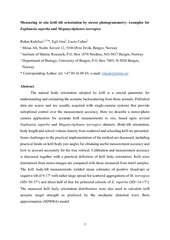Measuring in situ krill tilt orientation by stereo photogrammetry: examples for Euphausia superba and Meganyctiphanes norvegica
Journal article
Submitted version

View/
Date
2015-05-12Metadata
Show full item recordCollections
Original version
https://doi.org/10.1093/icesjms/fsv077Abstract
The natural body orientation adopted by krill is a crucial parameter for understanding and estimating the acoustic backscattering from these animals. Published data are scarce and are usually acquired with single-camera systems that provide suboptimal control over the measurement accuracy. Here we describe a stereo-photo camera application for accurate krill measurements in situ, based upon several Euphausia superba and Meganyctiphanes norvegica datasets. Body-tilt orientation, body length and school volume density from scattered and schooling krill are presented. Some challenges to the practical implementation of the method are discussed, including practical limits on krill body yaw angles for obtaining useful measurement accuracy and how to account accurately for the true vertical. Calibration and measurement accuracy is discussed together with a practical definition of krill body orientation. Krill sizes determined from stereo-images are compared with those measured from trawl samples. The krill body-tilt measurements yielded mean estimates of positive (head-up) or negative tilt of 9-17° with rather large spread for scattered aggregations of M. norvegica (SD=30-37°) and about half of that for polarized schools of E. superba (SD=14-17°). The measured krill body orientation distributions were also used to calculate krill acoustic target strength as predicted by the stochastic distorted wave Born approximation (SDWBA) model.